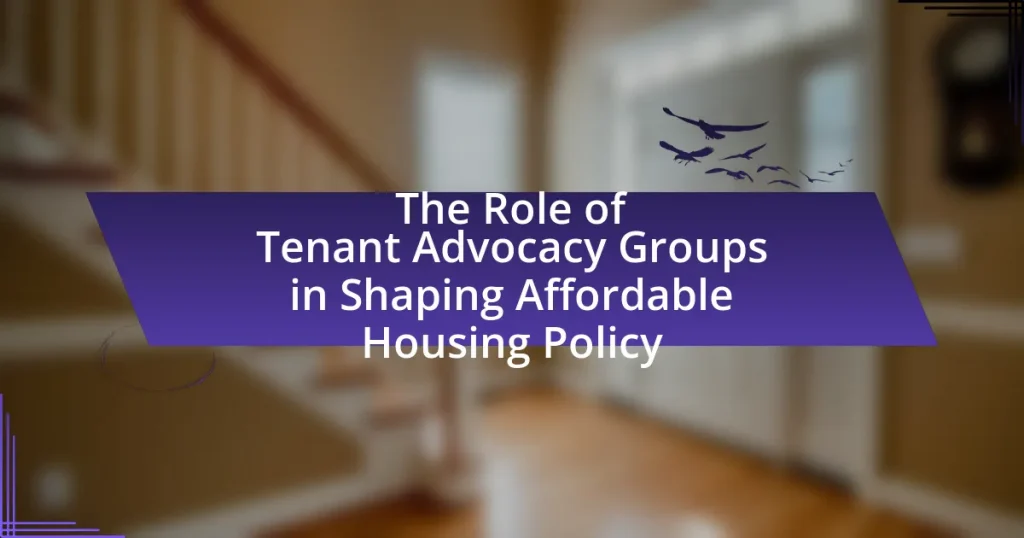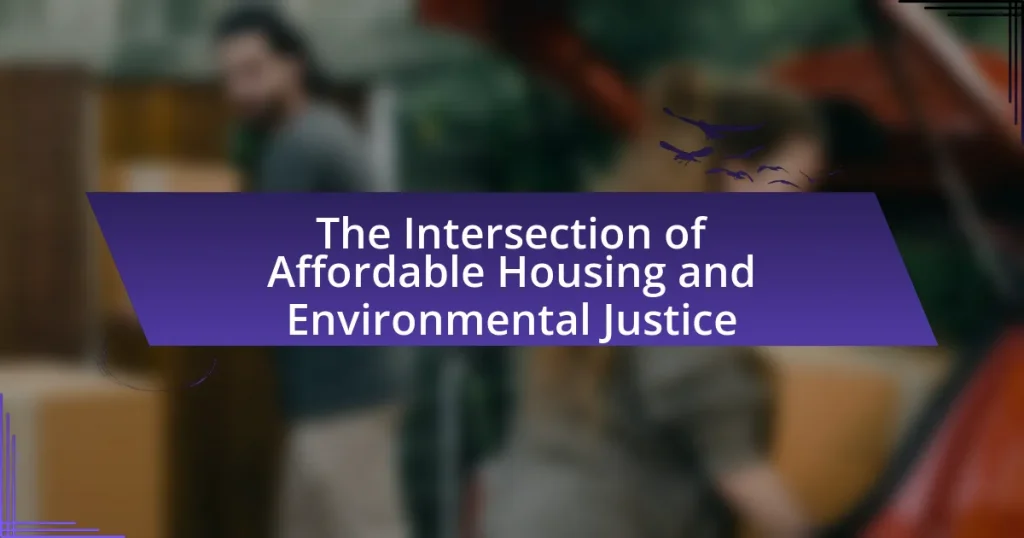Affordable housing is a critical component of economic recovery in the post-pandemic landscape, influencing job creation, consumer spending, and community stability. The article examines how access to affordable housing enhances financial security for low-income families, thereby stimulating local economies and reducing homelessness. It highlights the direct correlation between affordable housing and economic activity, job growth, and public health outcomes, while also addressing the challenges faced in developing such housing in the current environment. Additionally, the article discusses the role of policy changes and government programs in supporting affordable housing initiatives, emphasizing the long-term benefits of investing in this sector for community resilience and economic mobility.

What is the Importance of Affordable Housing in Economic Recovery Post-Pandemic?
Affordable housing is crucial for economic recovery post-pandemic as it directly impacts job creation, consumer spending, and overall economic stability. Access to affordable housing enables individuals and families to allocate more of their income towards essential goods and services, thereby stimulating local economies. According to a report by the National Low Income Housing Coalition, every $1 invested in affordable housing generates approximately $1.50 in economic return, highlighting its role in revitalizing communities. Furthermore, affordable housing reduces homelessness and housing instability, which are linked to increased healthcare costs and decreased productivity, further emphasizing its importance in fostering a resilient economy.
How does affordable housing contribute to economic stability?
Affordable housing contributes to economic stability by providing low-income families with secure living conditions, which in turn enhances their financial security and spending power. When families have access to affordable housing, they can allocate more of their income towards essential goods and services rather than excessive rent, leading to increased consumer spending. According to a report by the National Low Income Housing Coalition, every $100 increase in rent can lead to a 0.5% decrease in local spending, demonstrating the direct link between housing affordability and economic activity. Furthermore, stable housing reduces the likelihood of homelessness, which can strain public resources and social services, thereby promoting a healthier economy overall.
What role does affordable housing play in job creation?
Affordable housing plays a crucial role in job creation by providing stable living conditions that enable individuals to seek and maintain employment. When housing is affordable, workers can allocate more of their income towards transportation, education, and other job-related expenses, which increases their employability and productivity. According to a report by the National Association of Home Builders, every 100 affordable housing units built can create approximately 100 jobs in construction and related industries, demonstrating a direct correlation between affordable housing development and job growth.
How does affordable housing impact local businesses?
Affordable housing positively impacts local businesses by increasing consumer spending and stabilizing the workforce. When residents have access to affordable housing, they experience lower living costs, which allows them to allocate more of their income towards local goods and services. A study by the National Low Income Housing Coalition found that for every $1 invested in affordable housing, local economies can see a return of $1.50 to $2.00 in economic activity. Additionally, affordable housing contributes to a stable workforce, as employees are less likely to relocate due to housing instability, ensuring that businesses have a consistent pool of workers. This stability fosters business growth and encourages new investments in the community.
Why is affordable housing essential for community resilience?
Affordable housing is essential for community resilience because it provides stability and security for low- and moderate-income families, enabling them to withstand economic shocks. When housing is affordable, families can allocate more resources to health, education, and savings, which strengthens the overall economic fabric of the community. Research from the National Low Income Housing Coalition indicates that communities with higher rates of affordable housing experience lower rates of homelessness and better health outcomes, demonstrating that access to affordable housing directly correlates with enhanced community resilience.
How does affordable housing affect public health outcomes?
Affordable housing significantly improves public health outcomes by providing stable living conditions that reduce stress and promote well-being. Research indicates that individuals living in affordable housing experience lower rates of chronic diseases, improved mental health, and better access to healthcare services. For instance, a study published in the American Journal of Public Health found that families in affordable housing reported fewer instances of anxiety and depression compared to those in unstable housing situations. Additionally, affordable housing initiatives can lead to decreased emergency room visits and hospitalizations, as stable housing allows for better management of health conditions.
What are the social benefits of affordable housing in communities?
Affordable housing in communities fosters social stability and cohesion. It provides low-income families with access to safe and stable living conditions, which can lead to improved health outcomes, educational opportunities, and reduced crime rates. Studies indicate that neighborhoods with affordable housing experience lower levels of stress and higher levels of community engagement, as residents are more likely to participate in local activities and support one another. For instance, a report by the National Low Income Housing Coalition highlights that affordable housing contributes to better mental health and well-being, as families are less burdened by housing costs and can allocate resources towards education and healthcare.
What challenges does affordable housing face in the post-pandemic era?
Affordable housing faces significant challenges in the post-pandemic era, primarily due to increased demand and rising construction costs. The COVID-19 pandemic has exacerbated housing insecurity, leading to a surge in the number of individuals and families seeking affordable options. According to the National Low Income Housing Coalition, there is a shortage of 7 million affordable rental homes for extremely low-income renters, highlighting the critical gap in availability. Additionally, supply chain disruptions and labor shortages have driven up construction costs, making it more difficult for developers to build new affordable housing units. These factors combined create a complex landscape for affordable housing initiatives, hindering efforts to provide adequate housing solutions in the wake of the pandemic.
How has the pandemic affected housing supply and demand?
The pandemic has significantly disrupted housing supply and demand by causing a decrease in new construction and an increase in demand for suburban and rural properties. During the pandemic, many construction projects were halted due to lockdowns and labor shortages, leading to a decline in housing inventory. According to the National Association of Realtors, existing home sales surged by 20% in 2020, while new home construction lagged, resulting in a tight housing market. This imbalance has driven up home prices, making affordable housing increasingly scarce, which is critical for economic recovery post-pandemic.
What barriers exist to developing affordable housing?
Barriers to developing affordable housing include high construction costs, zoning regulations, and limited access to financing. High construction costs arise from rising material prices and labor shortages, making it financially challenging for developers to create affordable units. Zoning regulations often restrict the types of housing that can be built in certain areas, limiting the availability of land for affordable projects. Additionally, limited access to financing can hinder developers’ ability to secure the necessary funds, as traditional lenders may be hesitant to invest in affordable housing due to perceived risks and lower profit margins. These factors collectively impede the growth of affordable housing options, which are crucial for economic recovery post-pandemic.
How can policy changes enhance affordable housing initiatives?
Policy changes can enhance affordable housing initiatives by increasing funding for housing programs and implementing zoning reforms. Increased funding allows for the development of more affordable units, as evidenced by the National Low Income Housing Coalition’s report, which states that every $1 billion invested in affordable housing creates approximately 14,000 jobs and generates $2.3 billion in economic activity. Zoning reforms can facilitate the construction of affordable housing by reducing regulatory barriers, as seen in cities like Minneapolis, which eliminated single-family zoning to promote diverse housing options. These policy adjustments directly address the housing crisis exacerbated by the pandemic, making housing more accessible to low-income families and stimulating economic recovery.
What government programs support affordable housing development?
Government programs that support affordable housing development include the Low-Income Housing Tax Credit (LIHTC), the HOME Investment Partnerships Program, and the Community Development Block Grant (CDBG) program. The LIHTC incentivizes private investment in affordable housing by providing tax credits to developers, which has led to the creation of over 3 million affordable housing units since its inception in 1986. The HOME program allocates federal funds to states and localities to create affordable housing for low-income households, resulting in the development of approximately 1 million units annually. The CDBG program provides flexible funding to local governments for a variety of community development needs, including affordable housing initiatives, with over $3 billion allocated annually. These programs collectively play a crucial role in addressing the affordable housing crisis and supporting economic recovery efforts.
How can local governments incentivize affordable housing projects?
Local governments can incentivize affordable housing projects by offering tax credits, grants, and streamlined permitting processes. For instance, the Low-Income Housing Tax Credit program has successfully increased the availability of affordable units by providing developers with financial incentives to build or rehabilitate housing for low-income families. Additionally, local governments can implement inclusionary zoning policies that require a percentage of new developments to be affordable, thereby ensuring that affordable housing is integrated into community planning. These strategies have been shown to effectively stimulate the construction of affordable housing, addressing the critical need for such projects in the wake of economic challenges exacerbated by the pandemic.
What are the long-term implications of investing in affordable housing?
Investing in affordable housing has significant long-term implications, including enhanced community stability, increased economic mobility, and improved public health outcomes. Affordable housing contributes to community stability by reducing homelessness and housing insecurity, which in turn fosters stronger neighborhoods and social cohesion. Research from the National Low Income Housing Coalition indicates that stable housing leads to better educational outcomes for children, as they can remain in the same schools, thereby enhancing their long-term prospects.
Moreover, affordable housing investments stimulate local economies by creating jobs in construction and maintenance, which can lead to increased consumer spending in the community. A study by the National Association of Home Builders found that building 100 affordable homes can generate approximately 300 jobs and $28 million in local income.
Additionally, affordable housing can lead to improved public health outcomes, as stable housing reduces stress and exposure to environmental hazards. The Centers for Disease Control and Prevention highlights that individuals in stable housing are less likely to experience health issues related to homelessness or unstable living conditions.
Overall, the long-term implications of investing in affordable housing are multifaceted, positively impacting economic, social, and health dimensions within communities.
How does affordable housing influence economic mobility?
Affordable housing significantly enhances economic mobility by providing low-income families with stable living conditions that enable them to pursue better job opportunities and education. When families have access to affordable housing, they can allocate more resources toward essential needs such as education and transportation, which are critical for upward mobility. Research from the Urban Institute indicates that stable housing is linked to improved educational outcomes for children, which in turn increases their future earning potential. Additionally, affordable housing reduces the financial burden on families, allowing them to save and invest in their future, further promoting economic advancement.
What is the relationship between affordable housing and sustainable development?
Affordable housing is integral to sustainable development as it promotes social equity, economic stability, and environmental sustainability. Access to affordable housing ensures that low-income individuals and families can secure stable living conditions, which is essential for community well-being and economic participation. According to the United Nations, sustainable development goals emphasize the need for inclusive and sustainable urbanization, highlighting that affordable housing contributes to reducing inequalities and fostering resilient communities. Furthermore, sustainable housing practices, such as energy efficiency and sustainable materials, align with the principles of sustainable development, demonstrating that affordable housing can also minimize environmental impact while supporting economic recovery, particularly in the context of post-pandemic recovery efforts.
What best practices can be adopted for successful affordable housing projects?
Successful affordable housing projects can be achieved by implementing community engagement, leveraging public-private partnerships, and ensuring sustainable design. Community engagement fosters local support and addresses specific needs, as evidenced by studies showing that projects with community input have higher satisfaction rates. Public-private partnerships can enhance funding and resource allocation, with successful examples like the Low-Income Housing Tax Credit program in the United States, which has financed over 3 million affordable housing units since its inception. Sustainable design practices, such as energy-efficient building materials and renewable energy sources, not only reduce long-term costs but also contribute to environmental goals, aligning with the growing emphasis on sustainability in urban development.



